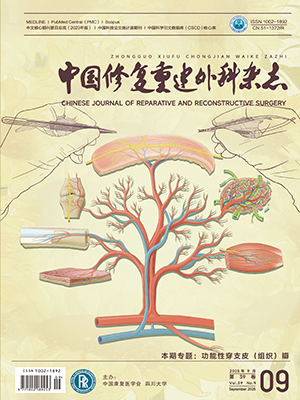Objective To investigate the diagnosis and effectiveness of surgical treatment for lumbar pyogenic spondyl itis. Methods Between February 2005 and June 2010, 15 cases of lumbar pyogenic spondyl itis were treated. There were 10 males and 5 females with an average age of 48.6 years (range, 26-72 years). Affected segments included L2, 3 in 3 cases,
L3, 4 in 3 cases, L4, 5 in 8 cases, and L5, S1 in 1 case. All cases had cl inical manifestations of moderate or severe fever, local pain of lesion, and l imitation of the spinal movement; 10 patients had nerve root symptoms, and 8 patients had symptoms of lower limb paraplegia. Leukocyte, C-reactive protein (CRP), and erythrocyte sedimentation rate (ESR) significantly increased in all cases. The preoperative X-ray and CT examinations showed no clear bone destruction; MRI showed decreased signal intensity on T1WI and increased signal intensity on T2WI, 7 cases had local ized abscess formation. The patients underwent focal cleaning and bone grafting and fusion combined with internal fixation, including anterior operation in 13 cases, posterior operation in 1 case, and combined anterior and posterior operation in 1 case. The results of bacterial culture were positive in 10 cases. According to the results of intraoperative bacterial cultures, sensitive antibiotics were selected. Results Healing of incision by first intention was achieved in 14 cases, healing by second intention in 1 case. After 2 weeks, 1 case recurred and symptoms was rel iefed after symptomatic treatment. Back pain and (or) lower limb pain were obviously improved in the other patients; body temperature recovered to normal after 3-4 days; leukocyte, ESR, and CRP significantly decreased. All the patients were followed up 12 to 70 months with an average of 35.4 months.The patients had no rejection, no fistula formation, no lumbar kyphosis, and no fixator loosening or breakage. The bony fusion time was 4-8 months. Conclusion Combination of cl inical manifestations, laboratory tests, and MRI can diagnose lumbar pyogenic spondyl itis, of which CRP is an important indicator to determine progression of the disease, and MRI is important for diagnosis. Debridement combined with interbody fusion and internal fixation is a safe and effective treatment method.
Citation: FulatiMaimaiti,SHENG Weibin,GUO Hailong,MAI Erdan,TU Laiyong,YU Shenghui,XUN Chuanhui.. SURGICAL TREATMENT OF LUMBAR PYOGENIC SPONDYLITIS. Chinese Journal of Reparative and Reconstructive Surgery, 2012, 26(7): 789-789. doi: Copy
Copyright © the editorial department of Chinese Journal of Reparative and Reconstructive Surgery of West China Medical Publisher. All rights reserved




